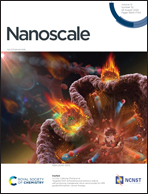Inkjet-defined site-selective (IDSS) growth for controllable production of in-plane and out-of-plane MoS2 device arrays†
Abstract
Along with the increasing interest in MoS2 as a promising electronic material, there is also an increasing demand for nanofabrication technologies that are compatible with this material and other relevant layered materials. In addition, the development of scalable nanofabrication approaches capable of directly producing MoS2 device arrays is an imperative task to speed up the design and commercialize various functional MoS2-based devices. The desired fabrication methods need to meet two critical requirements. First, they should minimize the involvement of resist-based lithography and plasma etching processes, which introduce unremovable contaminations to MoS2 structures. Second, they should be able to produce MoS2 structures with in-plane or out-of-plane edges in a controlled way, which is key to increase the usability of MoS2 for various device applications. Here, we introduce an inkjet-defined site-selective (IDSS) method that meets these requirements. IDSS includes two main steps: (i) inkjet printing of microscale liquid droplets that define the designated sites for MoS2 growth, and (ii) site-selective growth of MoS2 at droplet-defined sites. Moreover, IDSS is capable of generating MoS2 with different structures. Specifically, an IDSS process using deionized (DI) water droplets mainly produces in-plane MoS2 features, whereas the processes using graphene ink droplets mainly produce out-of-plane MoS2 features rich in exposed edges. Using out-of-plane MoS2 structures, we have demonstrated the fabrication of miniaturized on-chip lithium ion batteries, which exhibit reversible lithiation/delithiation capacity. This IDSS method could be further expanded as a scalable and reliable nanomanufacturing method for generating miniaturized on-chip energy storage devices.



 Please wait while we load your content...
Please wait while we load your content...
